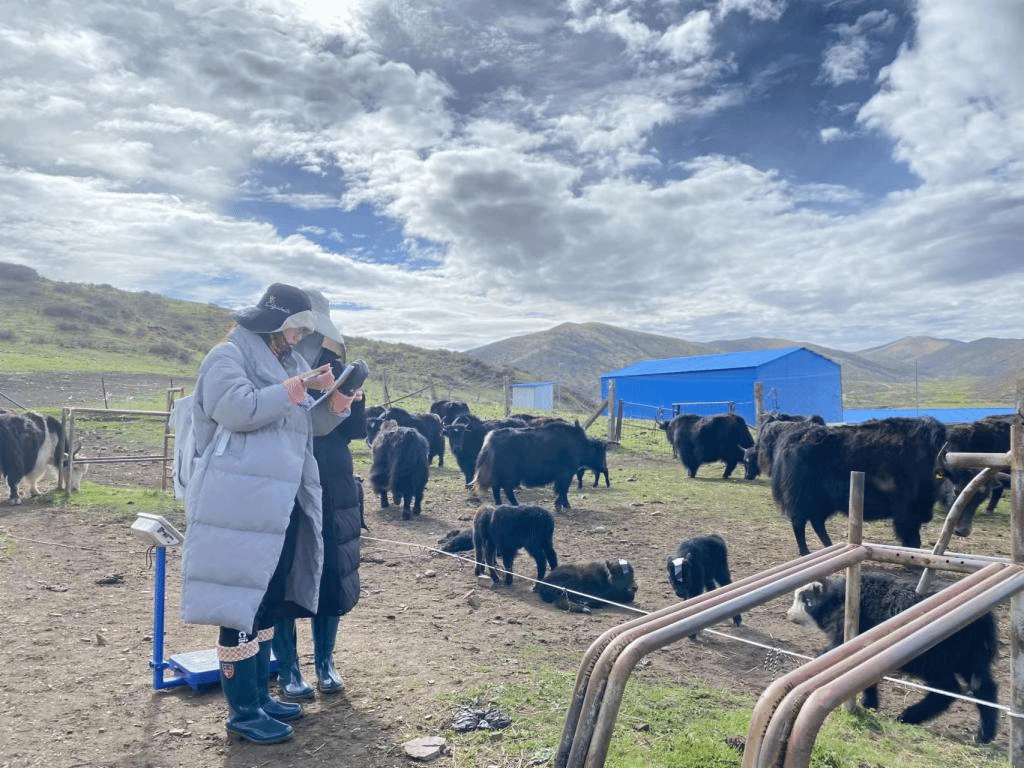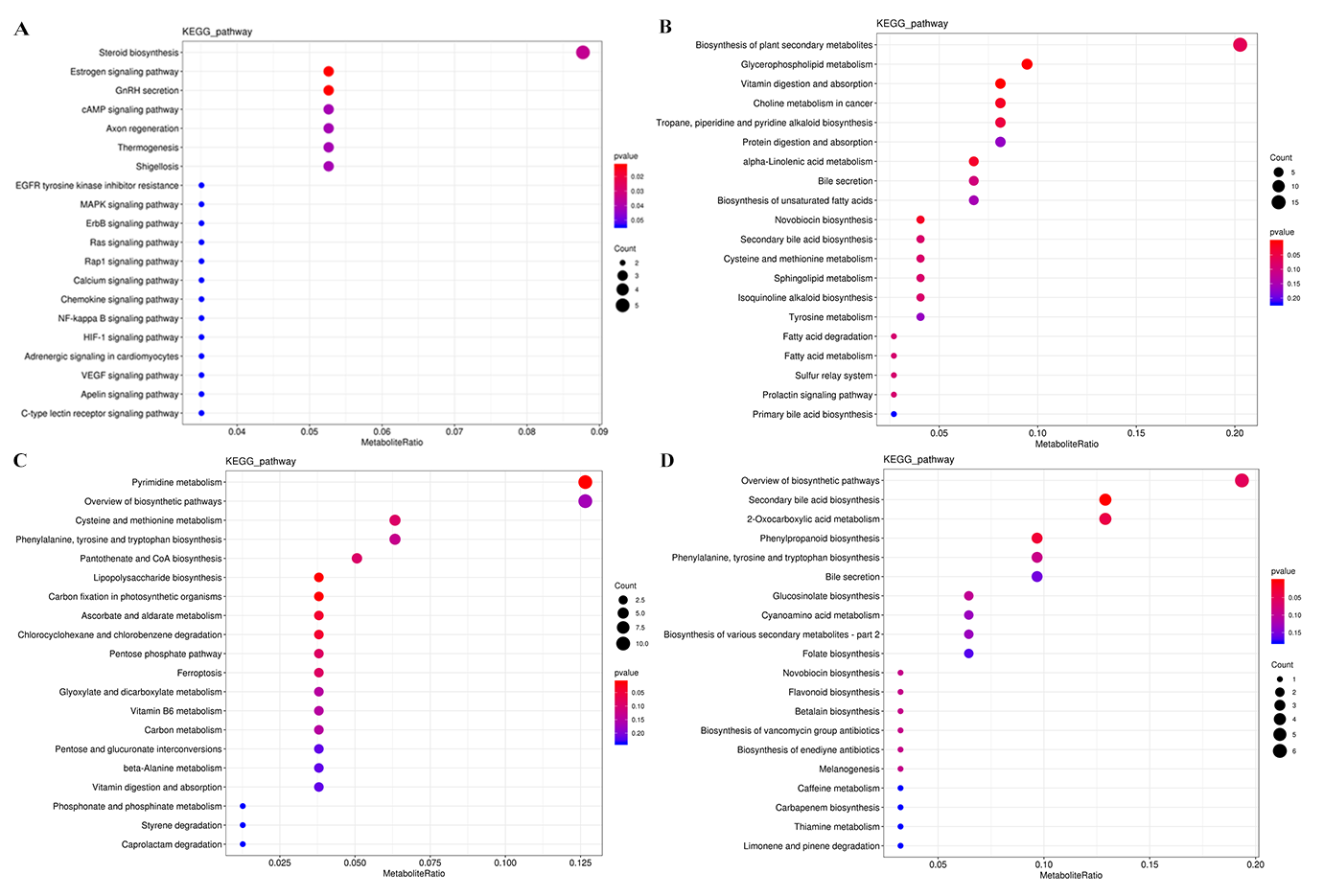南湖新聞網訊(通訊員 汪亞(ya) 蘋,李奧運)近日,學院李家奎教授團隊在犛牛源益生菌的研發及應用方麵取得重要進展。該論文發表於(yu) 國際微生物學術期刊Microbiology Spectrum。
犛牛是主要棲息在青藏高原高海拔缺氧環境的特有畜種,目前存欄1700多萬(wan) 頭,主要分布於(yu) 我國的青海、四川、甘肅、西藏等地,約占全世界犛牛總數的95%以上。犛牛具有重要的經濟和生態學價(jia) 值,是青藏高原的“能量轉換器”,把高原有限的生物能轉換成乳、肉、皮毛、燃料(糞便)等,同時還供役用。犛牛產(chan) 業(ye) 是我國青藏高原及毗鄰地區的特色和經濟支柱型產(chan) 業(ye) ,對於(yu) 促進藏區經濟發展、和諧穩定具有重要的社會(hui) 和生態意義(yi) 。然而,犢犛牛由於(yu) 胃腸道發育尚不成熟以及青藏高原惡劣的環境和營養(yang) 缺乏導致其胃腸道疾病高發和生長緩慢,給犛牛產(chan) 業(ye) 可持續發展帶來嚴(yan) 重威脅。為(wei) 實現犛牛產(chan) 業(ye) 綠色發展以及促進犢犛牛生長發育階段順利過渡,我校動物科學技術學院、動物醫學院李家奎教授毅然踏上三援藏區之路,長期從(cong) 事犛牛疾病防控和功能性益生菌開發等相關(guan) 研究,助力藏區犛牛產(chan) 業(ye) 技術優(you) 化升級,為(wei) 高原犛牛疾病防控事業(ye) 築起堅實的防護牆。李家奎老師團隊長期堅持在科研一線,基於(yu) 不斷嚐試從(cong) 健康犛牛的腸道內(nei) 篩選出對犢犛牛腸道發育和生長具有正向調節作用的乳酸杆菌和芽孢杆菌,為(wei) 馳援藏區犛牛產(chan) 業(ye) ,保證犛牛健康貢獻一份力量。
益生菌被發酵生產(chan) 製作成益生菌製粒後,運送至海拔3500米的四川阿壩藏族羌族自治州紅原縣進行田間試驗,以研究益生菌早期幹預對犢犛牛的生理效益。結果發現,飼喂益生菌的犢犛牛總體(ti) 重增長顯著高於(yu) 對照組,且分別比對照組體(ti) 重增加3.16kg、3.73kg。另外,飼喂益生菌對於(yu) 改善犢犛牛血清抗氧化特性(例如,超氧化物歧化酶,丙二醛,穀胱甘肽過氧化物酶,總抗氧化酶)和血清生化特性(例如穀草轉氨酶、總膽固醇、白蛋白)有一定的潛力。此外,試驗還發現,在益生菌策略的推動下,犢犛牛的腸道內(nei) 富集了更多的有益菌的類群(見於(yu) 圖2),且腸道代謝譜也發生了顯著變化,表現為(wei) 代謝物的濃度和代謝模式的變化,包括蛋白質消化和吸收、維生素消化和吸收以及次級代謝物的生物合成方麵的代謝物的富集(見於(yu) 圖3)。在該項目中,李家奎教授團隊在腸道微生態的基礎上製定了精確的益生菌幹預措施並取得了犢犛牛的生理效益,為(wei) 挖掘犛牛特異性腸道有益菌、減抗替抗、實現犛牛產(chan) 業(ye) 綠色發展以及犢犛牛胃腸道微生態平衡提供理論依據和實驗基礎。同時,也為(wei) 促進犢犛牛生長發育階段順利過渡,加快我國青藏高原地區犛牛產(chan) 業(ye) 可持續發展,促進藏區經濟發展貢獻一份力量。研究成果以“Effects of Milk Replacer-Based Lactobacillus on Growth and Gut Development of Yaks’ Calves: a Gut Microbiome and Metabolic Study”為(wei) 題發表,博士生汪亞(ya) 蘋為(wei) 論文的第一作者,李家奎老師為(wei) 論文的通訊作者。
近年來,李家奎教授致力於(yu) 犛牛益生菌菌種開發與(yu) 應用的研究,取得了係列成果,在Microbiology Spectrum,Frontiers in Microbiology,Microbial Cell Factories,Probiotics and Antimicrobial Proteins,Anaerobe,Microbial Pathogenesis等雜誌發表文章12篇,分離鑒定益生菌20多株,轉化生產(chan) 4株,為(wei) 犢犛牛早期生長發育調控奠定了理論和實踐依據。

圖1.李家奎老師團隊在四川紅原縣麥窪犛牛養(yang) 殖基地進行田間試驗。

圖2.腸道微生物群的相對豐(feng) 度在門和屬的水平上的顯著差異。*P< 0.05,**P< 0.01。

圖3.補飼益生菌驅動的不同的腸道代謝物和代謝途徑。在ESI+模式(A,B)和ESI-模式(C,D)中明顯改變的代謝途徑。
【英文摘要】
The gut microbiota anditsmetabolic activitiesare crucial in maintaining host homoeostasis and health, of which the role of probiotics has indeed been emphasized. The current study delves into the performance of probiotics as a beneficial managemental strategy,that furtherhighlightsits impact on growth performance, serologic investigation, gut microbiota, and metabolic profiling in yak calves. A field experiment was employed consisting of 2×3 factorial controls, including two development stages 21,and42 days(about 1 and a half months) with three different feeding treatments. Results showed a positive impact of probiotic supplements on growth performance by approximately 3.16 kg (p< 0.01) than blank control. Moreover, it had the potential to improve serum antioxidants and biochemical properties. We found that microorganisms that threaten health were enriched in the gut oftheblank control with the depletion of beneficial bacteria, although all yaks were healthy.Additionally, the gut was colonized bymicrobiota successionthat assembled into a more mature microbiome,driven by probiotics strategy. The gut metabolic profiling was also significantly changed afterthe probiotic’sstrategy, i.e., the concentrations of metabolites and the metabolic pattern, including enrichments in protein digestion and absorption, vitamin digestion and absorption,andbiosesynthesis of secondary metabolites. In summary, probiotics promoted gut microbiota/metabolites, developingprecise interventions, and achievingphysiological benefits based on intestinal microecology.Hence,it is important to understandabouttheprobiotic’s dietary changes togut microbiome, metabolome, and the host's phenotype.



